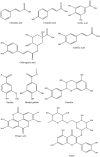Evaluation of Biomedical Applications for Linseed Extract: Antimicrobial, Antioxidant, Anti-Diabetic, and Anti-Inflammatory Activities In Vitro
- PMID: 37367264
- PMCID: PMC10299631
- DOI: 10.3390/jfb14060300
Evaluation of Biomedical Applications for Linseed Extract: Antimicrobial, Antioxidant, Anti-Diabetic, and Anti-Inflammatory Activities In Vitro
Abstract
Background: In the last few decades, the development of multidrug-resistant (MDR) microbes has accelerated alarmingly and resulted in significant health issues. Morbidity and mortality have increased along with the prevalence of infections caused by MDR bacteria, making the need to solve these problems an urgent and unmet challenge. Therefore, the current investigation aimed to evaluate the activity of linseed extract against Methicillin-resistant Staphylococcus aureus (MRSA) as an isolate from diabetic foot infection. In addition, antioxidant and anti-inflammatory biological activities of linseed extract were evaluated.
Result: HPLC analysis indicated the presence of 1932.20 µg/mL, 284.31 µg/mL, 155.10 µg/mL, and 120.86 µg/mL of chlorogenic acid, methyl gallate, gallic acid, and ellagic acid, respectively, in the linseed extract. Rutin, caffeic acid, coumaric acid, and vanillin were also detected in the extract of linseed. Linseed extract inhibited MRSA (35.67 mm inhibition zone) compared to the inhibition zone (29.33 mm) caused by ciprofloxacin. Standards of chlorogenic acid, ellagic acid, methyl gallate, rutin, gallic acid, caffeic acid, catechin, and coumaric acid compounds reflected different inhibition zones against MRSA when tested individually, but less than the inhibitory action of crude extract. A lower MIC value, of 15.41 µg/mL, was observed using linseed extract than the MIC 31.17 µg/mL of the ciprofloxacin. The MBC/MIC index indicated the bactericidal properties of linseed extract. The inhibition % of MRSA biofilm was 83.98, 90.80, and 95.58%, using 25%, 50%, and 75%, respectively, of the MBC of linseed extract. A promising antioxidant activity of linseed extract was recorded, with an IC50 value of 20.8 µg/mL. Anti-diabetic activity of linseed extract, expressed by glucosidase inhibition, showed an IC50 of 177.75 µg/mL. Anti-hemolysis activity of linseed extract was documented at 90.1, 91.5, and 93.7% at 600, 800, and 1000 µg/mL, respectively. Anti-hemolysis activity of the chemical drug indomethacin, on the other hand, was measured at 94.6, 96.2, and 98.6% at 600, 800, and 1000 µg/mL, respectively. The interaction of the main detected compound in linseed extract (chlorogenic acid) with the crystal structure of the 4G6D protein of S. aureus was investigated via the molecular docking (MD) mode to determine the greatest binding approach that interacted most energetically with the binding locations. MD showed that chlorogenic acid was an appropriate inhibitor for S. aureus via inhibition of its 4HI0 protein. The MD interaction resulted in a low energy score (-6.26841 Kcal/mol) with specified residues (PRO 38, LEU 3, LYS 195, and LYS 2), indicating its essential role in the repression of S. aureus growth.
Conclusion: Altogether, these findings clearly revealed the great potential of the in vitro biological activity of linseed extract as a safe source for combatting multidrug-resistant S. aureus. In addition, linseed extract provides health-promoting antioxidant, anti-diabetic, and anti-inflammatory phytoconstituents. Clinical reports are required to authenticate the role of linseed extract in the treatment of a variety of ailments and prevent the development of complications associated with diabetes mellitus, particularly type 2.
Keywords: anti-diabetic; anti-inflammatory; antioxidant; flavonoid; linseed; methicillin-resistant Staphylococcus aureus; phenolic.
Conflict of interest statement
The authors declare no conflict of interest.
Figures










Similar articles
-
Anti-Helicobacter pylori, Antioxidant, Antidiabetic, and Anti-Alzheimer's Activities of Laurel Leaf Extract Treated by Moist Heat and Molecular Docking of Its Flavonoid Constituent, Naringenin, against Acetylcholinesterase and Butyrylcholinesterase.Life (Basel). 2023 Jul 5;13(7):1512. doi: 10.3390/life13071512. Life (Basel). 2023. PMID: 37511887 Free PMC article.
-
Pharmacological Evaluation of Acacia nilotica Flower Extract against Helicobacter pylori and Human Hepatocellular Carcinoma In Vitro and In Silico.J Funct Biomater. 2023 Apr 21;14(4):237. doi: 10.3390/jfb14040237. J Funct Biomater. 2023. PMID: 37103327 Free PMC article.
-
Antimicrobial, Antidiabetic, Antioxidant, and Anticoagulant Activities of Cupressus sempervirens In Vitro and In Silico.Molecules. 2023 Nov 2;28(21):7402. doi: 10.3390/molecules28217402. Molecules. 2023. PMID: 37959821 Free PMC article.
-
In vitro activity of ceftaroline against multidrug-resistant Staphylococcus aureus and Streptococcus pneumoniae: a review of published studies and the AWARE Surveillance Program (2008-2010).Clin Infect Dis. 2012 Sep;55 Suppl 3:S206-14. doi: 10.1093/cid/cis563. Clin Infect Dis. 2012. PMID: 22903953 Review.
-
Sulopenem: An Intravenous and Oral Penem for the Treatment of Urinary Tract Infections Due to Multidrug-Resistant Bacteria.Drugs. 2022 Apr;82(5):533-557. doi: 10.1007/s40265-022-01688-1. Epub 2022 Mar 16. Drugs. 2022. PMID: 35294769 Review.
Cited by
-
Gamma rays and sodium azide induced variations in bio-physiological and agronomical traits in linseed (Linum usitatissimum L.).Heliyon. 2024 May 16;10(11):e31329. doi: 10.1016/j.heliyon.2024.e31329. eCollection 2024 Jun 15. Heliyon. 2024. PMID: 38845881 Free PMC article.
-
Pharmacological activities and phytochemical evaluation of coconut crude oil and upon exposure to ozone.AMB Express. 2025 Jan 2;15(1):3. doi: 10.1186/s13568-024-01813-1. AMB Express. 2025. PMID: 39747767 Free PMC article.
-
Experimental and in silico evaluation of Carthamus tinctorius L. oil emulgel: a promising treatment for bacterial skin infections.Front Cell Infect Microbiol. 2023 Sep 5;13:1253095. doi: 10.3389/fcimb.2023.1253095. eCollection 2023. Front Cell Infect Microbiol. 2023. PMID: 37731820 Free PMC article.
-
Effect of UV-C radiation on chemical profile and pharmaceutical application in vitro of Aloe vera oil.AMB Express. 2025 May 29;15(1):83. doi: 10.1186/s13568-025-01884-8. AMB Express. 2025. PMID: 40439784 Free PMC article.
-
Unveiling the in vitro activity of extracted Euphorbia trigona via Supercritical Fluid Extraction against pathogenic yeasts, obesity, cancer, and its wound healing properties.Bioresour Bioprocess. 2025 Apr 4;12(1):28. doi: 10.1186/s40643-025-00855-y. Bioresour Bioprocess. 2025. PMID: 40183897 Free PMC article.
References
-
- Abdel Ghany T.M., Ganash M., Alawlaqi M.M., Al-Rajhi A.M. Antioxidant, antitumor, antimicrobial activities evaluation of Musa paradisiaca L. pseudostem exudate cultivated in Saudi Arabia. BioNanoScience. 2019;9:172–178. doi: 10.1007/s12668-018-0580-x. - DOI
LinkOut - more resources
Full Text Sources

